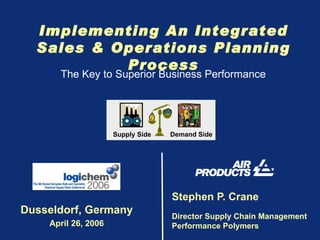
Implementing An Integrated Sales And Operations Planning Process
- 1. Stephen P. Crane Director Supply Chain Management Performance Polymers Implementing An Integrated Sales & Operations Planning Process Dusseldorf, Germany April 26, 2006 The Key to Superior Business Performance Supply Side Demand Side
- 4. Who is Air Products?
- 8. Global Work Processes Metrics Follow the Money!
- 13. S&OP Process Flow Steps P1.1A – Identify, Prioritize, & Aggregate SC Requirements DAY 0 - 8 P1.4 – Establish & Communicate SC Plans DAY 13-15 P1.3A – Balance Supply Chain Requirements with SC Resources DAY 9 – 12 P1.2A – Identify, Prioritize, & Aggregate SC Resources DAY 0 - 8 Review Historical Sales Data Review Demand Metrics Apply Historical Sales Data Adjustments Apply Future Demand Change Notifications Run Forecast Model Agree & Communicate Approved Plans Communicate Implications to Financial & Sales Plans Review Supply Plan & Cost Projections Develop/Modify Supply Chain Plans Review Supply Planning Measures Adjust Supply Planning Constraints Load & Review Unconstrained Demand Plan Submit Supply Plan with Documented Options Approve & Publish Supply Plan Approve & Publish Unconstrained Demand Plan Gather Data [DAY0] Gather Data [DAY 0] Define Supply Capability [DAY 1 – 8] Develop Supply Plan Proposals [DAY 9] Finalize & Approve Supply Plan [DAY 10 -12] Aggregate All Sources of Supply Initiate Req Master Data Changes Review Inventory Available Review Supply Capability Create Demand Change Summary B A Partnership Meeting [DAY 13] Executive S&OP [DAY 15] Summarize Supply Chain Plans Gather Collaborative Input (Future Function) Create Unconstrained Demand Plan [DAY 1 -8] Develop Unconstrained Revenue Projection Apply New Characteristic Combos Adjust Statistical Parameters (if needed) Review and Validate Unconstrained Forecast Input Source, Make, Deliver Product & Capacity Plans Create Supply Change Summary Develop Supply Plan Proposal (Optimization) Review Alerts Assess Impact & Develop Options Review Excess Capacity, Supply Options, Demand Exceptions Issue Resolution Agree to Supply Plan Initiate any Master Data MOC Review Supply Chain Plans Review Revenue Projections A B C C BI
- 14. S&OP Process Cycle Monthly Cycle Create Unconstrained Demand Plan (Days 1-7) Adjust Historical data, Statistical Forecast Develop Supply Plan Proposals (Days 7-9) Approved Demand Plan Partnership Meeting (Day 13) Approved Supply Plan (Days 10-12) Approved Plan Executive Meeting (Day 15) Balanced Plan Demand Change Summary (Day 0)
- 16. Demand Planning Process Data Gathering & Setup (Analysis, Exception Reporting, Statistical Models, Data Aggregation) Routine Forecasting Cycle (Demand Change Reviews, Sales History and Future Forecast Adjustments, Unconstrained Forecast) Monitor & Improve Forecast Accuracy (Forecast Accuracy KPI, Forecast Value Added from Business Intelligence) Sales & Operations Planning Process Inventory Plan Supply Plan MPS Raw Material Plan Distribution Plan Financial Forecast Process Network Optimization Rail Fleet Sizing Safety Stocks Capacity Planning Input from Marketing, Sales, Customers, & R&D
- 17. Supply Planning Process Data Gathering & Setup (Source, Make, Deliver, Product, & Capacity Plans) Define Supply Capability (Available Inventory, Sources of Supply, Summarize Supply Changes, Adjust Constraints, Initiate Master Data Changes) Develop Supply Plan Proposals (Assess Impact & Develop Options, Submit Supply Plan Options) Partnership Meeting MPS Raw Material Plan Distribution Plan Approve Supply Plan Input from Plants, Asset Management Network Optimization Changes Unconstrained Demand Plan
- 18. Partnership & Executive Meetings Review Demand Plan (Review Product Families, Demand Assumptions) Review Supply Plan (Inventory Plan, Cost Projections, Supply Assumptions, Issue Resolution) Agree to Supply Plan (Develop Supply Chain Plans, Source, Make, Deliver) Develop Revenue Projections (Identify Gaps) 18 Month Projections Communicate Approved Plans (Source, Make, Deliver) Communicate Plan Implications (Financial, Sales)
- 19. S&OP Drives the Business Plan Create Unconstrained Demand Plan (Days 1-7) Revenue Forecasting Volume Forecasting Process Links Together Business, Supply Chain, and Finance Demand Change Summary (Day 0) Partnership Meeting (Day 13) Executive Meeting (Day 15) Develop Supply Plan Proposals (Days 7-9) S&OP Monthly Cycle Adjust Historical data, Statistical Forecast Approved Demand Plan Approved Supply Plan (Days 10-12) Approved Plan Balanced Plan Drives Business Plans: - Outlooks/Budgets - Sales/Marketing Plans - Gross Profit Forecast Drives Supply Chain Plans: - Plant Loadings - Inventory Levels - Raw Material Forecasts Financial Variances : volume, price & margin
- 22. Forecast Accuracy Improvement World Class Performance
- 23. Forecast Accuracy vs Inventory DOS Demand Forecast Accuracy (%) Inventory Days of Supply Target Target 20% Improvement
- 24. Production Plan Adherence 38% Improvement
- 25. Financial Forecast Accuracy 21% Improvement
- 33. Thank you! Stephen Crane Director Supply Chain Air Products and Chemicals [email_address]
Notes de l'éditeur
- Introduction S&OP was first implemented in 1997. The process matured over time and ran fairly well until 2002. That’s when we began implementing SAP. S&OP was discontinued for about one year during the implementation. Then in 2003, S&OP was implemented again with new processes, tools, and data sources. So this is the story of implementing S&OP in a post SAP environment. Air Products is now 3 years into a 5 year project to install SAP company-wide. In today’s fast changing world, the need for an integrated business planning process is essential. Many companies lack the ability to integrate customer demand plans with an integrated supply chain. They lack the ability to integrate new activities into their businesses, which leads to projects being late and/or over budget. They lack the ability to update continuously the Business Plan and hence the Strategic Plan. Relying on a single annual budget as the basis of performance is increasingly recognized as an inadequate management control process. Sales & Operations Planning (S&OP) is an integrated management process where the executive team continually achieves focus and alignment among all the functions of the organization. The S&OP process is a communications and decision-making process that sets the direction, priorities and the boundaries for the rest of the organization. It regularly and routinely reviews customer demand and supply resources and “replans” across a rolling planning horizon. It provides for deployment of your strategic plan reviewing new products and projects and integrating them with the demand, supply and financial management of the business. .
